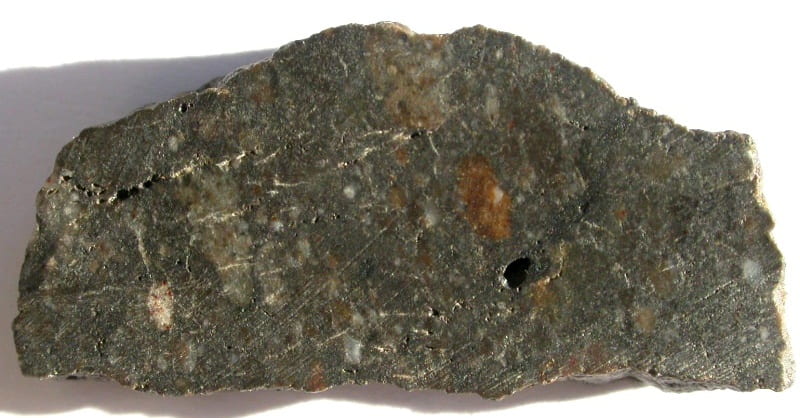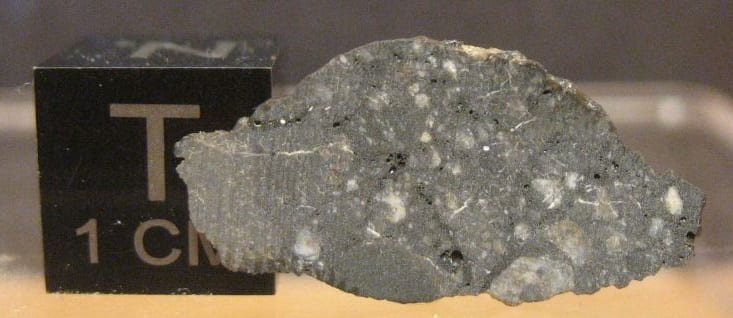Lunar Meteorite: Dhofar 1436 & 1443
paired stones





|
from The Meteoritical Bulletin, No. 93 Dhofar 1436Dhofar, Sultanate of Oman Lunar meteorite (feldspathic impact melt breccia) History: This meteorite was discovered by an anonymous finder on a limestone plateau in the Dhofar region of Sultanate of Oman, far from other known lunar meteorites. Physical characteristics: A single brownish-green stone of 24.2 g total weight. Fusion crust is absent. Petrography: (Lorenz C. and Nazarov M., Vernad) The meteorite is an impact melt breccia, consisting of lithic and mineral clasts embedded in a partly devitrified glassy matrix with abundant bubbles. The lithic clasts are mainly impact melt breccias and rocks of anorthositic, gabbro-anorthositic, and gabbro-noritic compositions. Granular breccia clasts are also present. Lithic fragments range from 0.01 to 7 mm in size. Major minerals are pyroxene and feldspar, with minor olivine. Accessories are silica, chromite, ilmenite, Ca-phosphate, troilite and FeNi metal. Mineral composition and geochemistry: (Lorenz C., Kononkova N., Vernad, EMP): feldspar (An92.5-98.7Ab1.1-7.2); orthopyroxene (En68.2-84.1Wo0.2-5.0; Fe/Mn 62); clinopyroxene (En13.4-63.7Wo12.8-40.5; Fe/Mn 63); olivine (Fo42.6-72.7; Fe/Mn 96); spinel is Al-Ti-chromite. Average glassy matrix composition: SiO2 = 45.1, TiO2 = 0.26, Al2O3 = 30.8, FeO = 4.49, MgO = 3.94, CaO = 16.7, Na2O = 0.48, K2O = 0.04 [all wt%]. Oxygen Isotopes: (I. A. Franchi, OU) δ17O=3.286; δ18O=6.244 (both ‰) Classification: Lunar meteorite (feldspathic impact melt breccia): minor weathering. Specimens: A type specimen of 5.2 g and one thin section are on deposit at Vernad. An anonymous collector holds the main mass. |
|
from The Meteoritical Bulletin, No. 95 Dhofar 1443Oman Lunar (anorthositic breccia) History: On April 12, 2001, one stone was found by an anonymous finder in the Dhofar region, Oman. Some years later three further tiny fragments were found within a few feet. The total mass of all stones is 36.7 g. Physical characteristics: The rock is slightly weathered and relatively dark in hand specimen. Petrography and mineralogy (A. Bischoff, IfP and E. H. Haiderer, Vienna): typical anorthositic breccia with light anorthositic clasts and abundant impact melt clasts embedded within a tough, partially molten matrix. This mostly devitrified matrix contains abundant vesicles and schlieren. Based on the optical appearance the rock has some similarities with Dhofar 081, however, the coordinates do not favor pairing. Mineral compositions: feldspar ranges from An83–98 with a mean of An94.8 ± 3.5; pyroxene is Fs12–49; mean: Fs30 ± 9; and olivine is Fa19–52; mean: Fa35.5 ± 9. Classification: Lunar (anorthositic breccia). Type specimens: 7.4 g and one polished thin section (IfP, Mün); an anonymous collector holds the main mass. |
| Randy Says… Dhofar 1436 and Dhofar 1443 were collected <800 m from each other. They are similar in appearance and identical in composition. We assume that they are paired. Although JaH 348 is reported to have been collected 143 km away, it is also similar in appearance and composition. The two meteorites might be launch paired. |
More InformationMeteoritical Bulletin DatabaseMapSchematic Map of Find Locations of Lunar Meteorite from Oman ReferencesKorochantseva E. V., Trieloff M., Hopp J., Buykin A. I., and Korochantsev A. V. (2009) 40Ar-39Ar dating of solar gas-rich lunar meteorite Dhofar 1436. 72nd Annual Meeting of the Meteoritical Society, abstract no. 5226. Korochantseva E. V., Buikin A. I., Hopp J., Korochantsev A. V., and Trieloff M. (2016) 40Ar-39Ar results of lunar meteorites Dhofar 025, 280, 309, 730, 733, 1436, 1442, SaU 449, NWA 6888. 79th Annual Meeting of the Meteoritical Society, abstract no. 6317. Korochantseva E. V., Buikin A. I., Verchovsky A. B., Hopp J., Korochantsev A. V., Anand M., and Trieloff M. (2017) Noble gas, N and C stepwise heating and crushing data for the lunar meteorite Dhofar 1436. 80th Annual Meeting of the Meteoritical Society, abstract no. 6258. Korochantseva E. V., Buikin A. I., Hopp J., Verchovsky A. B., Korochantsev A. B., Anand M., and Trieloff M. (2021) The lunar Dhofar 1436 meteorite: 40Ar‐39Ar chronology and volatiles, revealed by stepwise combustion and crushing methods. Meteoritics & Planetary Science 56, 455-481. Korotev R. L. (2008) Using composition to assess pairing relationships among lunaites. Geochimica et Cosmochimica Acta 72, 12S, A492. Korotev R. L. (2011) Lunar meteorites from Antarctica and Oman. 74th Annual Meeting of the Meteoritical Society, abstract no. 5073. Korotev R. L. (2012) Lunar meteorites from Oman. Meteoritics & Planetary Science 47, 1365-1402. Korotev R. L. (2015) In the feldspathic highlands of the Moon, high MgO/FeO equals high olivine abundance. 78th Annual Meeting of the Meteoritical Society, abstract no. 5078. Korotev R. L. (2017) Update (2012–2017) on lunar meteorites from Oman. Meteoritics & Planetary Science 52, 1251-1256. All Korotev data on Omani lunar meteorites. Korotev R. L., Zeigler R. A., Irving A. J., and Bunch T. E. (2009) Keeping up with the Lunar Meteorites – 2009. 40th Lunar and Planetary Science Conference, abstract no. 1137. Nazarov M. A., Aranovich Ya., Demidova S. I., Ntaflos T., and Brandstätter F. (2011) Aluminous enstatites of lunar meteorites and deep-seated lunar rocks. Petrology 19, 13-25. |